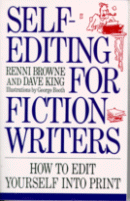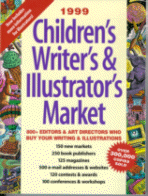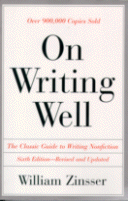Reviews of Writing Books
Self-Editing for Fiction Writers by Renni Browne and Dave King
HarperCollins, 1994.Paperback, 226 pages.
ISBN: 0062720465
Ordering information:
Amazon.com.
 Many writers do not even know
where to begin when it comes
time to edit their manuscripts.
Professional editors Renni Browne
and Dave King
help to demystify the process
in Self-Editing for Fiction Writers.
The book focuses on
numerous concepts writers often
struggle with, including: showing
and telling, characterization, point of view,
dialogue, repetition, proportion,
interior monologue, paragraph length,
style and voice.
Instruction in the book is driven home
with effective examples and concrete
advice.
Each section also includes
self-editing exercises with answers
included in the back of the book so
writers can check their progress.
A reading list of other resources
is also included.
Many writers do not even know
where to begin when it comes
time to edit their manuscripts.
Professional editors Renni Browne
and Dave King
help to demystify the process
in Self-Editing for Fiction Writers.
The book focuses on
numerous concepts writers often
struggle with, including: showing
and telling, characterization, point of view,
dialogue, repetition, proportion,
interior monologue, paragraph length,
style and voice.
Instruction in the book is driven home
with effective examples and concrete
advice.
Each section also includes
self-editing exercises with answers
included in the back of the book so
writers can check their progress.
A reading list of other resources
is also included.
Self-Editing for Fiction Writers is like having a professional editor looking over your shoulder, helping you to avoid the most common mistakes writers make and to polish your manuscript into a professional format more likely to attract that agent's or editor's attention. A great aide for writers of all levels.
1999 Children's Writers and Illustrator's Market edited by Alice Pope
Writer's Digest Books, January 1999.Trade Paperback, 392 pages.
ISBN: 0898798779
Ordering information:
Amazon.com.
 This year's edition of this
valuable resource for children's
writers and illustrators contains
new market resources, articles
and interviews. The first section
of the book contains information
on the basics of the business, including: information
on submitting
manuscripts and illustrations,
an article on how to make a picture book dummy,
networking, writer's groups,
interviews with authors who
have made their first sale and
other tips to help beginners in
the children's book business.
Market listings in the book provide
author and illustrator guidelines for
publishers of books, magazines, puzzles,
greeting cards, games and plays.
The publisher listings include: emails, phone numbers,
physical addresses, website addresses, names of the editors,
what the publication is looking
for, payment terms, the amount of material
purchased annually and information on how to submit
your work.
Valuable tips and suggestions from the editors
and publishers are also included.
The market listings can be referenced alphabetically
and by genre and age-level.
Also included in the book are
listings for writing conferences, clubs,
contests and organizations.
This year's edition of this
valuable resource for children's
writers and illustrators contains
new market resources, articles
and interviews. The first section
of the book contains information
on the basics of the business, including: information
on submitting
manuscripts and illustrations,
an article on how to make a picture book dummy,
networking, writer's groups,
interviews with authors who
have made their first sale and
other tips to help beginners in
the children's book business.
Market listings in the book provide
author and illustrator guidelines for
publishers of books, magazines, puzzles,
greeting cards, games and plays.
The publisher listings include: emails, phone numbers,
physical addresses, website addresses, names of the editors,
what the publication is looking
for, payment terms, the amount of material
purchased annually and information on how to submit
your work.
Valuable tips and suggestions from the editors
and publishers are also included.
The market listings can be referenced alphabetically
and by genre and age-level.
Also included in the book are
listings for writing conferences, clubs,
contests and organizations.
The 1999 Children's Writer's & Illustrators Market is a complete resource for children's writers and illustrators with practical advice on the business end of writing for children and accurate and up-to-date listings of publishers looking to buy children's stories and illustrations. An exceptional reference which any children's writer or artist must own.
On Writing Well by William Zinsser
HarperCollins, April 1998.Trade Paperback, 308 pages.
ISBN: 0062735233
Ordering information:
Amazon.com.
 This guide to writing effective
nonfiction provides
instruction and examples
on how to improve your
overall nonfiction writing, and
also provides advice on specific types
of nonfiction writing.
The first section of the book covers
general writing issues such as
style, word usage, openings, endings
and grammar. The second series of chapters
provides instruction on writing in
different nonfiction
genres including: literary nonfiction,
interviews, travel articles, memoirs,
science, business writing, sports,
arts and humor. The final chapters
in the book address finding your
unique writing voice, having
confidence in your work and the
decisions that writers make.
This guide to writing effective
nonfiction provides
instruction and examples
on how to improve your
overall nonfiction writing, and
also provides advice on specific types
of nonfiction writing.
The first section of the book covers
general writing issues such as
style, word usage, openings, endings
and grammar. The second series of chapters
provides instruction on writing in
different nonfiction
genres including: literary nonfiction,
interviews, travel articles, memoirs,
science, business writing, sports,
arts and humor. The final chapters
in the book address finding your
unique writing voice, having
confidence in your work and the
decisions that writers make.
This valuable writers tool was developed by William Zinsser from his teachings of writing at Yale University. This is the sixth edition of the book and includes new chapters that urge writers to live interesting lives, focus on specific portions of the article they are writing as opposed to the entire article, and establish a distinctive writer's voice. On Writing Well is an inspirational and informative resource that any serious nonfiction writer should read at least once.
Return to the February 1999 issue of The IWJ.
More from Writers Write
